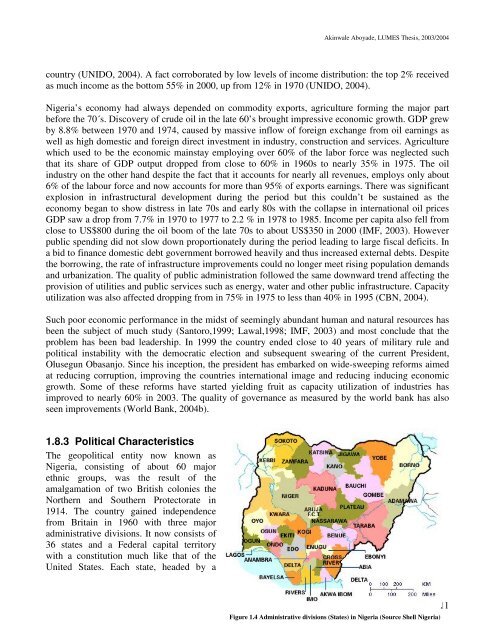Wale Aboyade's thesis - lumes
Wale Aboyade's thesis - lumes
Wale Aboyade's thesis - lumes
Create successful ePaper yourself
Turn your PDF publications into a flip-book with our unique Google optimized e-Paper software.
Akinwale Aboyade, LUMES Thesis, 2003/2004<br />
country (UNIDO, 2004). A fact corroborated by low levels of income distribution: the top 2% received<br />
as much income as the bottom 55% in 2000, up from 12% in 1970 (UNIDO, 2004).<br />
Nigeria’s economy had always depended on commodity exports, agriculture forming the major part<br />
before the 70´s. Discovery of crude oil in the late 60’s brought impressive economic growth. GDP grew<br />
by 8.8% between 1970 and 1974, caused by massive inflow of foreign exchange from oil earnings as<br />
well as high domestic and foreign direct investment in industry, construction and services. Agriculture<br />
which used to be the economic mainstay employing over 60% of the labor force was neglected such<br />
that its share of GDP output dropped from close to 60% in 1960s to nearly 35% in 1975. The oil<br />
industry on the other hand despite the fact that it accounts for nearly all revenues, employs only about<br />
6% of the labour force and now accounts for more than 95% of exports earnings. There was significant<br />
explosion in infrastructural development during the period but this couldn’t be sustained as the<br />
economy began to show distress in late 70s and early 80s with the collapse in international oil prices<br />
GDP saw a drop from 7.7% in 1970 to 1977 to 2.2 % in 1978 to 1985. Income per capita also fell from<br />
close to US$800 during the oil boom of the late 70s to about US$350 in 2000 (IMF, 2003). However<br />
public spending did not slow down proportionately during the period leading to large fiscal deficits. In<br />
a bid to finance domestic debt government borrowed heavily and thus increased external debts. Despite<br />
the borrowing, the rate of infrastructure improvements could no longer meet rising population demands<br />
and urbanization. The quality of public administration followed the same downward trend affecting the<br />
provision of utilities and public services such as energy, water and other public infrastructure. Capacity<br />
utilization was also affected dropping from in 75% in 1975 to less than 40% in 1995 (CBN, 2004).<br />
Such poor economic performance in the midst of seemingly abundant human and natural resources has<br />
been the subject of much study (Santoro,1999; Lawal,1998; IMF, 2003) and most conclude that the<br />
problem has been bad leadership. In 1999 the country ended close to 40 years of military rule and<br />
political instability with the democratic election and subsequent swearing of the current President,<br />
Olusegun Obasanjo. Since his inception, the president has embarked on wide-sweeping reforms aimed<br />
at reducing corruption, improving the countries international image and reducing inducing economic<br />
growth. Some of these reforms have started yielding fruit as capacity utilization of industries has<br />
improved to nearly 60% in 2003. The quality of governance as measured by the world bank has also<br />
seen improvements (World Bank, 2004b).<br />
1.8.3 Political Characteristics<br />
The geopolitical entity now known as<br />
Nigeria, consisting of about 60 major<br />
ethnic groups, was the result of the<br />
amalgamation of two British colonies the<br />
Northern and Southern Protectorate in<br />
1914. The country gained independence<br />
from Britain in 1960 with three major<br />
administrative divisions. It now consists of<br />
36 states and a Federal capital territory<br />
with a constitution much like that of the<br />
United States. Each state, headed by a<br />
Figure 1.4 Administrative divisions (States) in Nigeria (Source Shell Nigeria)<br />
11

















